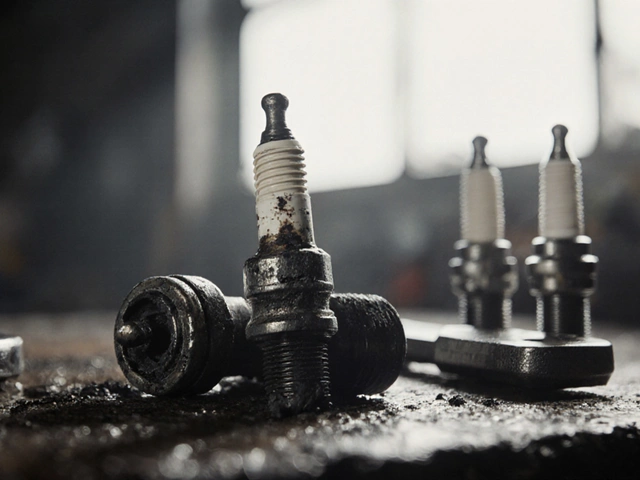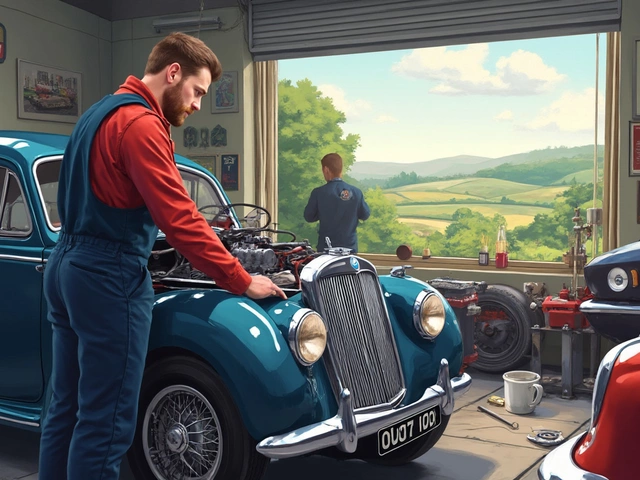Driving along a familiar road, you might notice your car feels a bit off. Suddenly, every small bump seems to jar the vehicle more than usual. In moments like these, it’s worth considering whether your car suspension might be calling out for attention.
The suspension system is more than just a collection of springs and shocks. It plays an essential role in ensuring that your tires remain in contact with the road, providing stability, handling, and comfort. A worn-out suspension can lead to a host of problems, including compromised safety and increased wear on other car components.
But how do you know when it's time to overhaul this critical part of your vehicle? It’s about listening and feeling what your ride is telling you. This guide is here to shed light on how to catch those subtle cues before they turn into costly repairs.
- Understanding the Role of Suspension
- Common Signs of Failing Suspension
- Evaluating Unusual Noises and Bumps
- When Professional Inspection is Necessary
- Preventive Measures for Suspension Maintenance
Understanding the Role of Suspension
The suspension system in your vehicle is often overlooked until a problem arises, yet it plays a vital role in ensuring both comfort and safety as you navigate the roads. At its core, the suspension system absorbs the shocks from the road, which might otherwise transfer all their jarring force directly to the vehicle's body and its occupants. By absorbing and dispersing this energy, the suspension system protects not only your spine from discomfort but also the vehicle's chassis and other components from excessive wear.
Every car suspension setup is a finely tuned combination of parts – including coil springs, shock absorbers (or struts), and anti-sway bars – that work in concert to manage the dynamics of motion. The simplest way to appreciate the impact of a well-functioning suspension is by understanding how it helps maintain traction. By keeping the wheels in consistent contact with the road, the suspension maximizes your control over the vehicle, especially during challenging maneuvers.
Consider the delicate balance a suspension maintains; too soft, and a car might 'float' and feel sluggish in response, too firm, and it could feel every bump and pothole with a jolt. In fact, sports cars are a prime example of vehicles where suspension tuning leans towards performance, offering tight handling at the cost of ride comfort. Conversely, luxury sedans and SUVs boast suspensions designed to cushion passengers in a sea of comfort.
It's not just about comfort and handling though; a compromised suspension means other areas of your vehicle will suffer. For instance, uneven suspension wear can lead to uneven tire wear, reducing their lifespan and potentially leading to a blowout on the road. It's clear then that the suspension indirectly affects fuel efficiency and even maintenance costs. As Edmunds explains, "When your suspension is in optimal condition, it keeps your vehicle aligned properly, ensuring that tires, axles, and steering components don't need to work harder than necessary."
"The suspension is the unsung hero of vehicle safety and comfort," says car expert Tom Magliozzi. "Without it, even the smoothest roads feel like the rutted tracks of the Wild West."
Understanding these fundamentals offers insight into why regular checks and maintenance of your suspension system are critical. The role of your car suspension goes beyond simple cushioning – it’s the guardian of your driving experience, subtly working as you journey from place to place.
Common Signs of Failing Suspension
Recognizing the signs of a failing car suspension is crucial in averting potential hazards and costly repairs. When your vehicle starts misbehaving, it's an essential skill to interpret these signals accurately. Perhaps you've felt your car drifting through turns more than it used to, or maybe every bump on the road feels harsher, shaking you to your core. These are not mere annoyances but rather red flags indicating the suspension might be heading towards a breakdown.
One telltale sign can be an uneven tire tread or excessive wear on specific parts of the tire. This happens because a failing suspension can't evenly distribute the vehicle's weight across the tires, leading to uneven contact with the road surface. When your tires begin to tell this unfortunate tale, it's a clear signal that a thorough inspection of your suspension system is in order. Checking tire alignment can provide further clues about how well the suspension is holding up under pressure.
Increased Stopping Distance
Another critical indicator is an increase in stopping distances. A worn suspension system shifts the weight of the car during braking unevenly, putting more stress on the brakes and making your stopping less effective. This becomes particularly dangerous in emergency situations, where every inch matters. Always check for any changes in how your vehicle responds during braking – it’s often subtle but likely a precursor to suspension issues. Consistent with the experience of many drivers, longer stopping distances can cause nerve-wracking moments in unexpected driving conditions.
Excessive bouncing or swaying also signals that suspension repair might be on the agenda. A hands-free test for this involves simply pushing your vehicle down at the front. If the car keeps bouncing several times after letting go, it's a good indication the suspension system, notably shock absorbers, may be worn out. This bounce test, simple as it might seem, gives deep insight into how well the vehicle handles kinetic energy absorption on uneven terrain.
Listen for Uncommon Sounds
If your car starts groaning, clunking, or knocking over bumps, it’s time to put on your detective hat. Strange noises often accompany suspension issues. These sounds usually result from worn-out components like bushings or joints that can no longer hold things together properly. A quiet ride is no longer just the promise of luxury but an indicator of a healthy suspension system, so pay attention to any out-of-the-ordinary sounds. Taking the car to a mechanic to investigate these noises can serve as a preventive measure against larger, more dangerous issues down the road.
According to an article by Car and Driver, “Regular checks and early detection can save drivers over 50% on potential costly repairs and replacements.” Hence, being proactive about suspension maintenance is not just about preserving a smooth ride; it’s functionally about safeguarding both your wallet and your wellbeing.

Evaluating Unusual Noises and Bumps
You've probably experienced the odd noise coming from your car when driving over bumps—sometimes a clunk here or a squeak there. While these sounds might seem harmless at first, they can often indicate issues within your car suspension. Knowing what to listen for and when to take action can save you from costly repairs down the line. Imagine a scenario where every bump is met with a symphony of unsettling noises; this shouldn’t just be dismissed as quirks of the road! These noises are usually your car's way of begging you to pay attention, whispering hints about wear and tear.
The first thing to note about noises is their nature and frequency. Clunky sounds, especially when turning or navigating over bumpy terrain, can suggest issues with the suspension joints. The ball joints and bushings may be the culprits here. Over time, these components wear out due to regular stresses they endure. If ignored, the damage could quickly escalate, even leading to steering challenges. Squeaking noises, on the other hand, often point towards issues with the spring, or maybe a need for lubrication. While it might sound like a minor annoyance, any persistent noise deserves attention.
When considering noises related to the suspension repair, it's essential to think about the car's behavior over irregular surfaces. Ever noticed excessive bouncing? This could hint at a failing shock absorber or strut. These components play a vital role in ensuring your vehicle smoothly glides over bumps without bouncing you about like a carnival ride.
"A vehicle’s ride quality isn’t just about comfort, it's intrinsically linked to road safety and handling," emphasizes automotive expert John Carruthers.Noises aren't merely nuisances but are intrinsically tied to how your car performs.
Determining the Source of Bumps
When evaluating your vehicle for unusual bumps, it's critical to differentiate where the feedback originates. For instance, if you sense vibrations through the steering wheel, it might indicate issues with the front-end suspension. The rear, conversely, can lead vibrations felt through the seat or cabin floor. Distinguishing these can guide a mechanic towards the precise area needing attention, optimizing repair efforts and costs. Professionals rely on these subtle markers to determine if a suspension system needs servicing or if the problem is elsewhere.
Moreover, track the frequency and conditions in which these vibrations occur. Do they intensify at higher speeds? Are they more pronounced on specific terrains? Asking these questions offers valuable insights into whether your whole suspension is in jeopardy or specific parts like the springs or shocks are at risk. A systematic approach, leveraging both sound and feel, can be instrumental.
The Role of Regular Maintenance
Routine checks and familiarity with what your car's typical response to bumps sounds and feels like pay off in the long term. If you're diligent, you might catch a worn component preemptively, turning what could be a massive repair into small, manageable tasks as part of your regular vehicle maintenance. During seasonal checkups, discuss these noises with your mechanic. They possess the expertise and experience to translate your noise descriptions into actionable insight on your car's condition. An ounce of prevention is surely worth a pound of cure, keeping your car reliable and your drives serene.
When Professional Inspection is Necessary
Your car is an intricate machine where each part plays a role in the symphony of driving. So, when the suspension—critical to the smoothness and safety of your journey—starts to falter, it might be time to turn to the experts. Even if you're an adept weekend warrior with a set of tools that would make any garage proud, there comes a time when the eye of a seasoned mechanic is required. Car suspension systems are not only about springs and shocks; they tie into other systems too, like steering and alignment. If these interconnected components start whispering or, worse yet, howling in distress, it might be time to have your vehicle checked by a professional. They have the diagnostic tools and the expertise to determine whether it's a simple fix or something potentially bigger lurking beneath.
Professional inspections become crucial when you start noticing persistent suspension problems you can't pinpoint. Imagine driving and hearing strange clunking noises every time you hit a bump or make a turn. Or perhaps you notice your car leaning heavily to one side, making your morning commute feel more like an amusement park ride than a drive down the boulevard. These could be signs of significant suspension issues, like worn-out shock absorbers or even damaged struts. While some drivers may avoid the mechanic until their car stops rolling, such signs should not be ignored for long. An earlier-than-expected inspection can prevent more extensive, costly repairs and possibly dangerous driving conditions.
Reliability is critical in a professional inspection. Not only does a mechanic offer a fresh set of eyes, but they provide a knowledgeable perspective shaped by countless under-the-hood experiences. According to the National Highway Traffic Safety Administration (NHTSA), suspension issues are one of the more common mechanical problems encountered by motor vehicles, highlighting the importance of attentive upkeep. In one illuminating quote from the American Automotive Service Solutions, it was noted, "Paying attention to your vehicle's minor quirks today can save you from major headaches tomorrow."
In the words of vehicle expert Laura Gonzales, "A suspension system is quite literally foundational to your vehicle’s performance and safety. Regular inspections allow you to catch that sagging spring before it bounces you into a more elaborate, expensive repair."
For those hinting at more than a DIY weekend project, most manufacturers recommend having your suspension looked over every 50,000 miles. However, if you're regularly driving on poor roads or carrying heavy loads, an inspection might be necessary even sooner. Check-ups don't just end with peace of mind; they offer opportunities for mechanics to examine everything including the wheel alignment, tire wear patterns, and whether there are any red flags indicating other potential issues in the vehicle's mechanisms.

Preventive Measures for Suspension Maintenance
Regular vehicle maintenance is the key to ensuring that your car suspension system remains in top-notch condition. By focusing on routine checks, you can address minor issues before they become major, potentially costly repairs. One of the essential strategies for preserving your suspension is maintaining proper tire alignment and rotation. Misalignment can lead to uneven tire wear, causing unnecessary stress on your suspension components. Mechanics recommend checking alignment at least once a year, or every 12,000 miles, whichever comes first.
Another crucial aspect is to be mindful of your driving habits. Aggressive driving, such as sudden stops or high-speed over bumps, can accelerate wear and tear on suspension parts. Ensuring that your vehicle is not carrying excessive weight beyond its capacity limit also plays a role in protecting your suspension. Overloading your car can lead to sagging springs and weakened shocks or struts.
It's also beneficial to routinely inspect your car for any visible signs of wear and corrosion. Check for leaks under the vehicle, particularly around shock absorbers and struts, which could indicate worn seals. A careful look at the car’s bushings is recommended, as these can deteriorate over time. Replacing them at the right moment can prevent damage to more expensive components of the suspension system.
Implementing a schedule that aligns with your car manufacturer’s recommended services is a proactive approach. A detailed examination by a trusted professional during regular servicing might not only save your suspension but also improve your vehicle's life span. Suspending disbelief and thinking longevity when it comes to suspension upkeep could be your car's saving grace. In light of experts’ words,
“Regular maintenance and timely replacements are fundamental for a vehicle’s prolonged peak performance,”a seasoned mechanic at a national automotive chain once shared.






